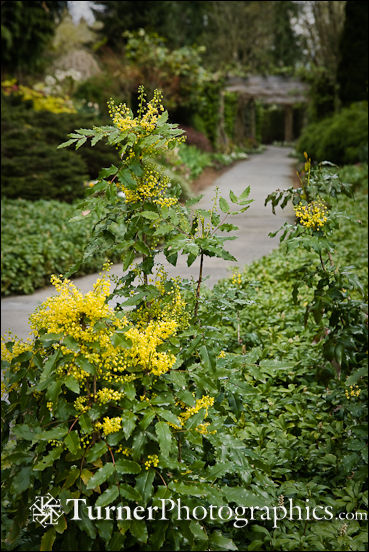Plant of the Month: Tall Oregon Grape
 One of the first of our northwest native shrubs to bloom is Tall Oregon Grape, Mahonia aquifolium. It also goes by the name Shining Oregon Grape because its foliage is a bright glossy green.
One of the first of our northwest native shrubs to bloom is Tall Oregon Grape, Mahonia aquifolium. It also goes by the name Shining Oregon Grape because its foliage is a bright glossy green.
I’ve seen precocious flowers as early as mid-January in a warm, protected and sunny spot. The bright yellow blossoms, held in upright clusters at the ends of the branches, have a mildly sweet scent. On a warm winter day bees will be busy darting from blossom to blossom, collecting this early source of nectar and pollen.
In the wild, Tall Oregon Grape grows on both sides of the Cascades. It’s adaptable, thriving both at woodland edges where it gets a fair amount of shade and also in full sun. It blooms better when it gets more sunlight.
The three northwest species of Oregon Grape are most easily distinguished by their foliage, although Tall Oregon Grape usually lives up to its name by growing to 6 feet, considerably taller than the other two.
Tall Oregon Grape has 5-9 leaflets, twice as long as wide, with prominent spines and glossy upper leaf surfaces. My Pacific Northwest Wildflowers website has more photos of Mahonia aquifolium.
Dull Oregon Grape, M. nervosa, is a low-growing shrub that has 9-19 leaflets with the leaf veins mostly parallel, and a dull upper leaf surface (thus the common name). See more photos.
Trailing Oregon Grape, M. repens, is an east side species, although it grows quite happily in west side gardens. It’s also a low-growing shrub, with 5-7 roundish leaflets that are less than twice as long as wide, and small teeth. See more photos.
 All three species are evergreen, although they’re subject to wind burn and foliage loss during some particularly hard winters. They spread by underground rhizomes but don’t become invasive.
All three species are evergreen, although they’re subject to wind burn and foliage loss during some particularly hard winters. They spread by underground rhizomes but don’t become invasive.
Oregon Grape fruit is edible, but tart. The dark blue berries look like small clusters of grapes. Most people who use the fruit turn it into jelly or jam. Birds and other wildlife also like the berries.

